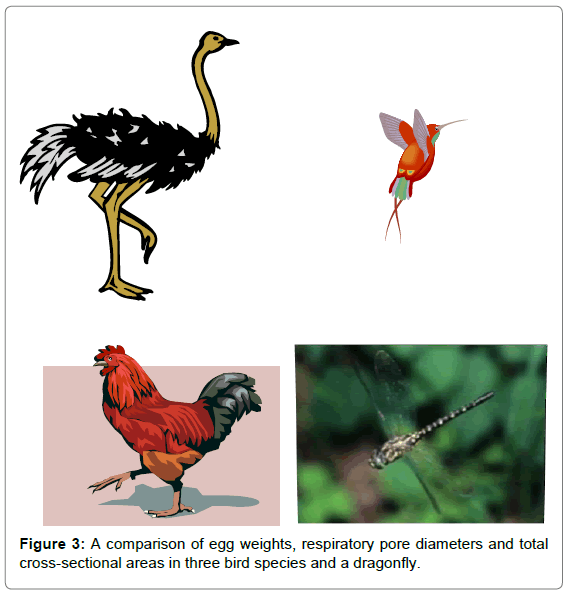A Comparison of Respiratory Pores in Avian and Dragonfly Eggshells
Received: 08-Feb-2018 / Accepted Date: 21-Feb-2018 / Published Date: 05-Mar-2018
Introduction
Avian fetus in chicken eggs and dragonfly eggs consume oxygen diffusing through breathing pores on egg shells. Three types of pores in avian egg shells are morphologically classified to simple straight pores, trampet shaped pores and branched pore systems [1]. Complexed breathing pores exist on egg shells in running big birds. Depressions where pores are open can be clearly seen on fossil Moa egg shell fragments also [2]. Many Scientists studied hard to estimate effective surface area for the sufficient inflow of air.
Avian Fetus Consumes Oxygen Diffusing in Through Breathing Pores on Egg Shells
Problems in oxygen uptake in avian eggshells
Avian fetus has no active machine for oxygen uptake. It is protected in egg shells. The protection, however, causes some trouble. Rain drops block the respiratory pores easily.
Japanese cranes leave their eggs in their nest once their eggs get wet by the unexpected shower. Breathing pores of the eggshells are soon closed by the unexpected shower drops (Figure 1). Parent cranes detect the unhappy event and soon give up their effort for hatching their eggs. They give up their effort for hatching and leave their eggs.
Parent cranes detect the unhappy event, soon give up their effort for hatching and leave their eggs, once their eggs are wet by shower. The parent cranes know that their fetus should be kept dry and supplied with oxygen. Fetus should be warmed to maintain their high metabolic rates. They are readily suffocated, once loosing oxygen supply through respiratory pores.
Oviposition and eggshell surface in a dragonfly
The female dragonfly, Sarasaaeschna pryeri, lays eggs in clean fresh water shown in Figure 2. A scanning electron microscopic micrograph (right) of an egg shell surface is shown on the right-hand side. Many micropores can be seen on the cuticle surface.
The female dragonfly, Sarasaaeschna pryeri, understands that her small eggs should be kept in the clean fresh water containing much oxygen, to maintain their metabolic engine. Oxygen molecules dissolved in water move into the larva inside of the eggshell by diffusion through micro-pores open for oxygen.
Reasonable biological designs exist in the biological world
A comparison of egg weights, respiratory pore diameters and total cross-sectional areas in three bird species and a dragonfly (Figure 3) are mentioned in Table 1 [3].
| Species | Egg White | Pore Diameter | Pore Length | Total Pore Area% |
|---|---|---|---|---|
| Ostrich | 1368 g | 107.0 μm | 1920 μm | 0.11% |
| Dom. hen | 60 g | 13.8 μm | 350 μm | 0.03% |
| Nectarinia | 0.86 g | 2.5 μm | 50 μm | 0.00% |
| Sarasaaeschna pryeri dragonfly |
0.0014 g | 74.7 nm | ? | 0.17% |
Table 1: A comparison of egg weights, respiratory pore diameters and total cross-sectional areas in three bird species and a dragonfly are summarized in the table.
Discussion
Large variations in the size and shape were induced in the biological world.
Remarkable evolutional changes proceeded also in “eggshells”. In eggshells of the dragonfly respiratory pores are formed in the egg cuticle [4].
The fundamental passage route for oxygen is small pores running through egg shells. The huge egg shell of ostrich has a pore diameter of hundred micro-meter. The small sized pore of dragon fly egg cuticle is designed by the nature also for the steady oxygen passage but only through a very small size. Oxygen flows in according to the physical gradient of the oxygen following the physical law. If too much oxygen is supplied to eggs, the excessive oxygen destroys the biological tissue by super-oxidation. Thus, a clever selection proceeded over a long time in nature.
Conclusion
Reasonable respiratory micro-pores exist on avian and dragonfly eggshells as the results of natural selection. Hence, we can say that nature has a big role to play with the living world.
References
- Toien O, Paganelli CV, Rahn H, Johnson RR (1988) Diffusive resistance of avian eggshell pores. Respir Physiol 74: 345-354.
- Hyman RW, Fukushima M, Diamond L, Kumm J, Giudice LC, et al. (2005) Microbes on the human vaginal epithelium. Proc Natl Acad Sci 102: 7952-7957.
- Amos AR, Rahn H (1985) Pores in avian eggshells: gas conductance, gas exchange and embryonic growth rate. Resp Physiol 61: 1-20.
- Koyama T, Takano H, Yokoyama T (2011) Micropores in the vitteline layer of the eggs of the dragonfly Oligoaeshna pryeri: a preliminary observation from the viewpoint of oxygen uptake. Adv Exp Med Biol 701: 307-310.
Citation: Koyama T (2018) A Comparison of Respiratory Pores in Avian and Dragonfly Eggshells. J Vet Med Health 2: 105.
Copyright: © 2018 Koyama T. This is an open-access article distributed under the terms of the Creative Commons Attribution License, which permits unrestricted use, distribution, and reproduction in any medium, provided the original author and source are credited.
Share This Article
Recommended Journals
Open Access Journals
Article Usage
- Total views: 3765
- [From(publication date): 0-2018 - Mar 12, 2025]
- Breakdown by view type
- HTML page views: 3074
- PDF downloads: 691



